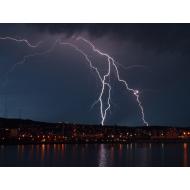Different protection systems designs have been made for solving these issues.
An example of this is ELT’s ITP (Input Transient Protection – Surge protection at input) family, conceived and designed to provide additional safety and robustness for any electronic equipment exposed to sudden surges in general equipments, for instance the phenomena created by lightning in lighting components like ballasts for HID, FLUO and LED drivers or modules.
In addition, different ways of normalizing these problems have emerged from international regulatory bodies. In this situation, the International Electrotechnical Commission (IEC) defined the 61643-11/2007 standard where three types of protection equipment against ‘surges’ or transients are recognised:
- Type 1. Devices designed to withstand a direct hit from lightning. They are characterised by a current waveform of 10/350 microseconds.
- Type 2. Devices designed to withstand lightning overvoltages and induced or conducted switchings. They are characterized by a current wave of 8/20 microseconds.
- Type 3. Devices designed to withstand lightning overvoltages and induced or conducted switching. They are characterized by a combination of a current waveform of 8/20 microseconds, and a voltage waveform of 1.2/50 microseconds. ELT’s ITP equipment falls within this classification.
Within the Type 3 protective devices, as recommended by IEEE and ANSI standard C62.41.2, we differentiate between recommended levels of protection of 6kV/3kA or 10kV/10kA, depending on the equipment’s level of exposure to this type of phenomena.
ELT’s ITP protective equipment has a ratio of protection for several pulses or lightnings of 10kV/3kA, although they can withstand surges of up to 8kA.
Furthermore, they are suitable for protecting Class I or Class II fixtures connected to mains up to 277V in outdoor installations. Regardless of whether the system is connected to ground (common mode disturbance) or not (disturbance in differential mode), ELT auxiliary protection equipment is suitable for installation and its use does not mean regulatory problems, efficiency issues or other aspects.
How are phenomena that cause damage to outdoor electronic equipment produced? How does an ITP auxiliary system protection work?
When we refer to phenomena that can cause damage to electronic equipment for outdoor use, we usually refer to lightnings.
Lightnings consists of electrostatic discharges produced by an accumulation of electrical charge, usually in the clouds close to the physical Earth. Once the voltage between these two points is enough, great electrical discharges can be produced.
These phenomena have a really short duration, but the amount of energy produced in microseconds is by no means negligible. In fact, a direct hit from one of these phenomena in a facility will likely damage or destroy electronic equipment inside the luminaires. Even equipments around can suffer irreparable damage, as 3kA current transients can occur (or in some cases transients with an even stronger current).
Even if lightning does not hit the electronic system directly, a high movement of charges (in short, a current) in an LED luminaire can cut the power supply and the LED module, or simply the power supply. Furthermore, the level of isolation in this type of luminaires is not usually greater than 6kV, because generally you have to place the LED module close to the body of the luminaire to dissipate the heat produced.
Protective systems based on ITP technology try to control the weakest link in the chain in case of a potential discharge phenomenon, like lightning. Thus, before reaching the breakdown voltage of the luminaire system with respect to ground, they produce a discharge through their self-protection system that carries potentially dangerous energy to earth.
In Class I luminaires, the ITP must be connected to earth in the set. In Class II luminaires, it must be connected to the functional ground of the luminaire.
The dimensions of the ITP auxiliary protection system are very small, allowing its use in any installation that requires a high level of protection against lightning or other similar phenomena.
ITP auxiliary protection system is correctly wired by wiring cables as short as possible and directly connected to the power supply, ballast or other equipment to protect. Otherwise, the voltages induced at the power supply terminals can be even greater than those of the disturbance itself. If you cannot properly install the ITP system, you must redefine the system’s protection capacity.






